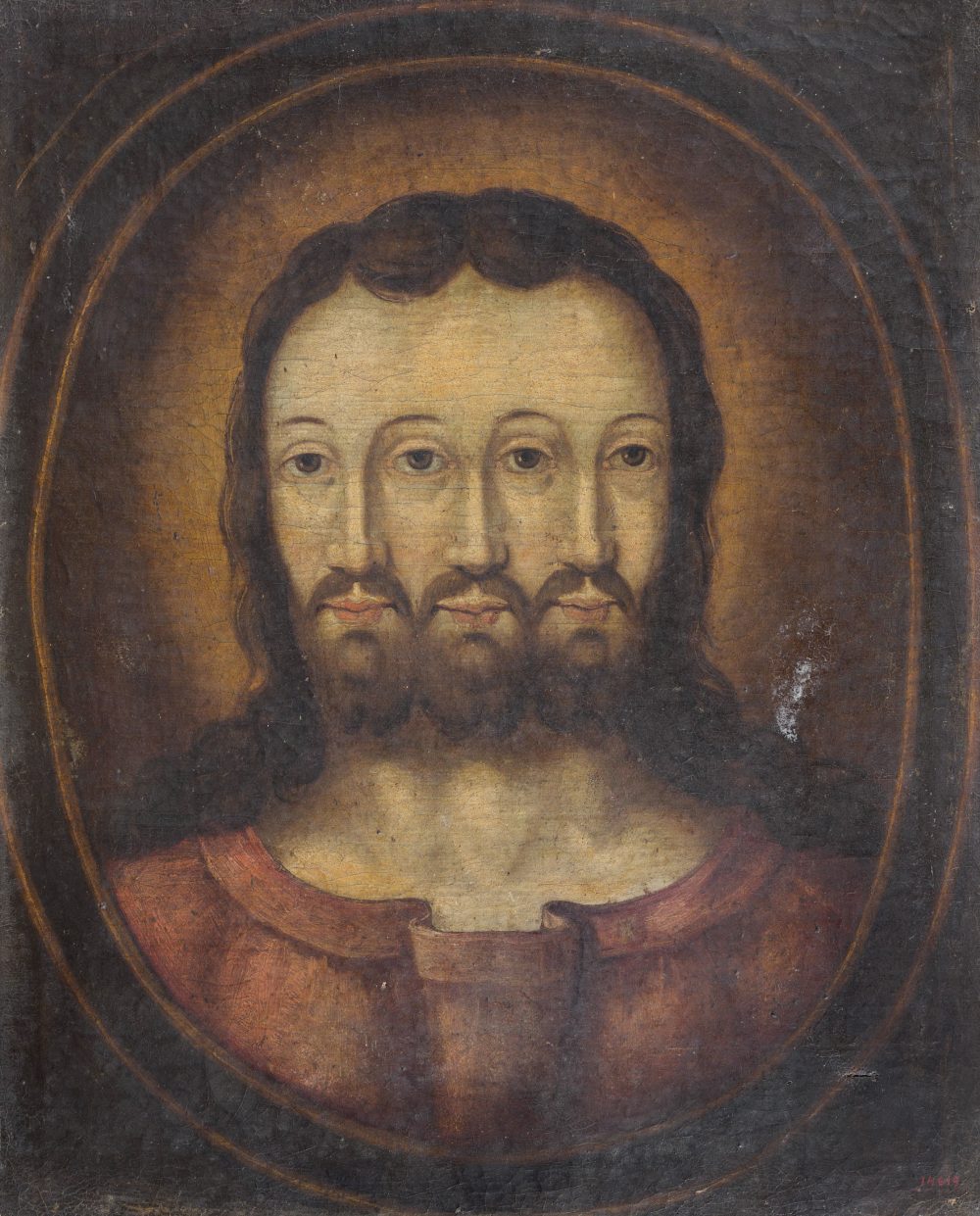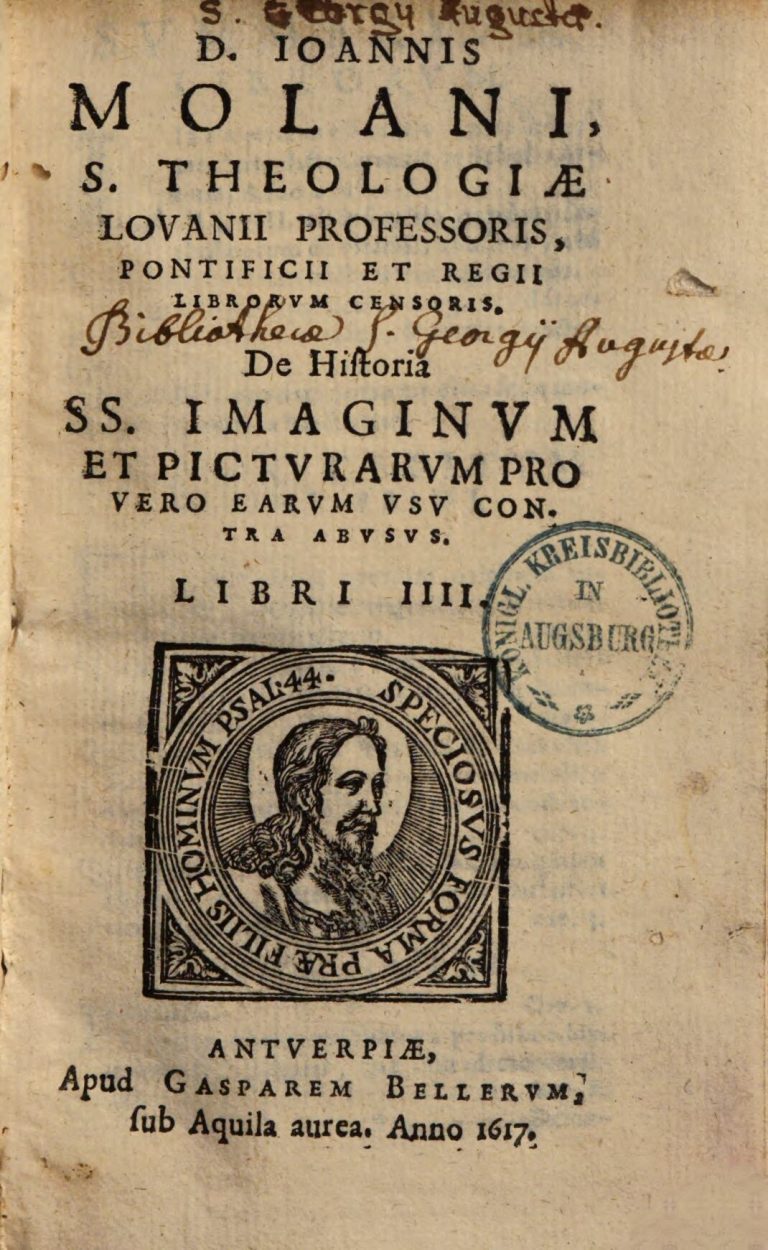
Website of the Museu Nacional d’Art de Catalunya of Barcelona, www.museunacional.cat
In chapter 4 of book 2, Molanus deals with two rather widespread iconographies of the Holy Trinity that are disapproved by the commentators as impious and diabolical.
The second example in this chapter is the depiction of the Holy Trinity as one man with three heads or as one head with three faces. This iconography, of which examples can be found all over the Early Modern Christian world, is condemned by Molanus as a monster of nature and a diabolical invention.
“As for the second type of image, its conception is better known, because some editors, in the sacramentaries, or to use a more common expression today: in the missals, have put it in the frontispiece to the office of the Holy Trinity, these images represent the Trinity as if it were only one man, with three heads or at least three faces. The famous theologians of Louvain, of very pious memory, have refuted in their books the conception of this representation: Messire Jacques Latomus, of Cambron, and Jean Hessels, of Louvain; before them, Saint Antoninus, the archbishop of Florence, in his Summa, called this kind of images: ‘a monster of nature.’
I would add that this representation is a diabolical invention. Indeed, Robert, the abbot of Mons, who completed the Chronicle of Siegbert de Gembloux, tells us that ‘in the year 1221, in the church of the Premonstratensians, in the morning the Devil showed himself to a brother who was reflecting deeply on the ineffable Trinity that is God. He appeared to him wearing three heads, claiming that he was the Trinity and affirming that the brother, thanks to the merit of his faith, was worthy of His vision. But the brother recognized the enemy’s trickery, insulted him and forced him to leave.’ The life of Norbert relates the same facts in chapter 19, but with more detail.
In Damien de Goes’ book, we also read this quotation from an Ethiopian orator about the customs of the Ethiopians: ‘We say that the Father, the Son and the Holy Spirit are three faces with a single likeness and divinity.'”
Altera verò Imaginis ratio paulò notior est. Nam typographi quidam in Sacramentariis, sive ut nunc usitatius loquimur, in Missalibus libris, eam praeposuerunt officio de sancta Trinitate: pingentes videlicet Trinitatem ac si esset unus homo, set tribus capitibus, aut saltem tribus faciebus. Quam pingendi rationem in suis tribus capitibus, aut saltem tribus faciebus. Quam pigendi rationem in suis libiris refutarunt celebres Theologi Lovanienses pientissimae memoriae don Iacobus Latomus Cambronensis, et Ioannes Hesselius Lovaniensis, ante utrumqu vero sanctus Antonius, Florentinus Archiepiscopus in Summa: ubi huiusmodi imaginem vocat monstrum in rerum natura.
Addo picturam hanc sigmentum esse diabolicum. Sic enim scribit Robertus Abbas Montis, qui Chronicon Sigeberti Gemblacensis supplevit, anno 1221 in Praemonstratensi Ecclesia cuidam fratri altius de inessabili Trinitate quae Deus est cogitanti in Matutinis daemon astitit, et ei tria capita gestans apparuit, Trinitatem se esse constestans, et ob fidei meritum, Trinitatis visione eum dignum esse affirmans: sed frater inimic dolum agnoscens, conuiciando ei, recedere a se compulit. Haex Robertus, eademque habet susius vita Norberti, cap. 19. Legitur quoque, apud Damianum a Goes de Aethiopum moribus scribentem, Orator Aethiopiae referre: Nos dicimus Patrem et Filium et Spiritum Sanctum esse tres vultus in una similitudine et divinitate.

Molanus 1996, 134-135.; Joan Yeguas, “A three-faced Trinity at the Museu Nacional d’Art de Catalunya”, May 21 2021, Blog del Museu Nacional d’Art de Catalunya » A three-faced Trinity at the Museu Nacional d’Art de Catalunya.



